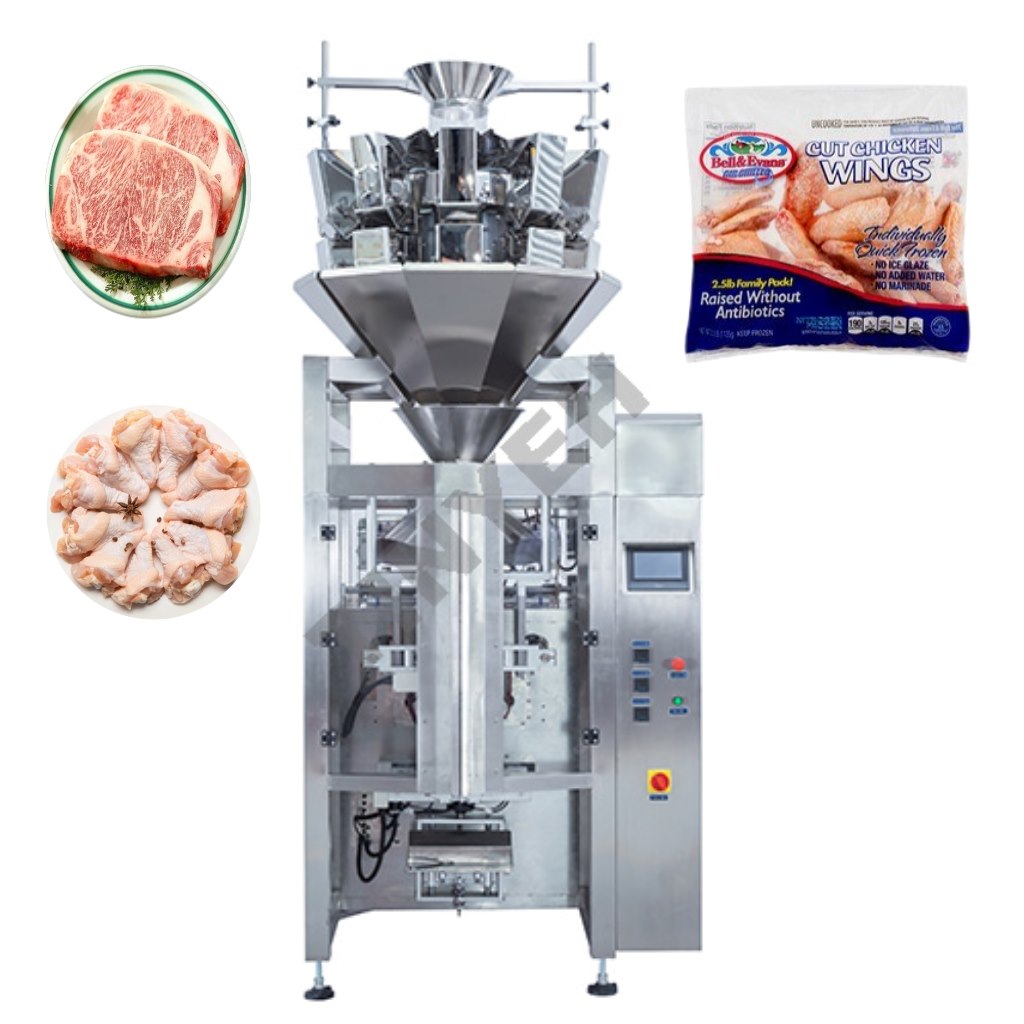Selecting the right frozen food packing machine is crucial for ensuring product quality, maintaining efficiency, and complying with food safety regulations. With the increasing demand for frozen foods, businesses must invest in equipment that can handle high volumes while preserving product integrity. A well-chosen packing machine can help reduce waste, improve production speed, and extend shelf life.
To make an informed purchase, it’s essential to consider key features that impact performance, durability, and overall functionality. Below, we outline the most important features when selecting a frozen food packing machine.
1. Temperature Control and Cold Resistance
To prevent thawing and contamination, frozen food must remain at consistently low temperatures throughout the packing process. A high-quality frozen food packing machine should be designed with materials and components that can operate efficiently in cold environments.
● Cold-resistant materials: Stainless steel or specially coated components to prevent freezing-related damage.
● Frost and condensation management: Built-in mechanisms to prevent ice buildup, which can affect sealing and machinery operation.
● Temperature monitoring sensors: Ensuring the food remains within the required frozen state during packaging.
2. High-Quality Sealing and Leak-Proof Technology
The quality of the seal is crucial in preventing air exposure, freezer burn, and contamination. A frozen food packing machine should have a reliable sealing mechanism to maintain product freshness and extend shelf life.
● Heat sealing or vacuum sealing technology to create airtight packaging.
● Double-seal or reinforced-seal options for high-moisture frozen products like seafood or marinated meats.
● Sealing consistency sensors to detect and adjust pressure or temperature for perfect seals every time.
3. Compatibility with Various Packaging Materials
Different frozen foods require different packaging solutions, such as vacuum-sealed bags, stand-up pouches, rigid trays, or flexible film wraps. A versatile packing machine should accommodate multiple packaging materials to suit a variety of products.
● Polyethylene (PE) and Polypropylene (PP): Ideal for flexible packaging and vacuum-sealed bags.
Laminated Films: Used for strong, durable packaging resistant to punctures.
● Rigid Plastic Trays: Suitable for ready-to-eat frozen meals and preportioned items.
● A machine with adjustable film roll holders and customizable sealing settings will provide greater flexibility for different types of frozen food packaging.
4. Speed and Automation Capabilities
Efficiency is key in frozen food production. A packing machine should be capable of handling high-speed operations without compromising accuracy.
A● utomatic weighing, filling, and sealing: Reducing manual labor and improving consistency.
● Programmable settings: Allowing operators to easily switch between different packaging types.
● Integration with robotics: Some machines can include robotic arms for precise food placement.
● A fully automated packing system not only increases production capacity but also minimizes human error and contamination risks.
5. Hygiene and Easy Cleaning Design
Hygiene is a top priority in food processing. A frozen food packing machine should be designed for easy cleaning and maintenance to comply with strict food safety regulations.
● Stainless steel construction: Prevents rust and bacterial buildup.
● Smooth, non-porous surfaces: Reduce residue accumulation.
● Tool-free disassembly: Allows quick cleaning of machine parts.
● CIP (Clean-in-Place) system: An automated cleaning process that sanitizes internal machine components.
● Machines that meet standards ensure compliance with food safety regulations.
Tinyeh Frozen Food Packing Machine
6. Precision in Weighing and Portioning
Consistency in portion size is critical for cost control and regulatory compliance. Advanced frozen food packing machines offer highly accurate weighing and filling mechanisms to ensure each package contains the correct amount of product.
● Multi-head weighers: Ideal for bulk frozen foods like vegetables and seafood.
● Auger fillers: Best suited for powdery or granular frozen items such as grated cheese.
● Linear weighers: Used for pre-portioned meals and protein-based frozen foods.
● A high-precision system reduces product giveaway and ensures uniform packaging.
7. Durability and Maintenance Requirements
A reliable frozen food packing machine should be built to last, minimizing downtime and reducing maintenance costs. Look for machines made from high-quality materials that resist wear and tear, even in extreme conditions.
● Heavy-duty stainless steel construction to prevent corrosion.
● Sealed electrical components to protect against moisture.
● Easy access panels for quick maintenance and repairs.
● Choosing a machine with a strong warranty and available replacement parts will ensure long-term performance.
8. Flexibility for Different Product Types
Frozen foods come in various shapes, sizes, and textures. A good packing machine should be able to handle a variety of products without requiring extensive modifications.
● Adjustable packaging formats: Ability to switch between bags, trays, and pouches.
● Customizable filling systems: Suitable for solid, liquid, or semi-liquid frozen foods.
● Modular designs: Expandability to accommodate future packaging needs.
● A machine with high flexibility allows businesses to diversify their frozen food offerings without investing in multiple machines.
9. Compliance with Food Safety Standards
Compliance with food industry regulations is mandatory for ensuring product safety and legal operation. Always choose machines that meet national and international food safety certifications. A compliant machine guarantees adherence to industry best practices and avoids regulatory issues.
10. Integration with Production Lines
For large-scale production, the frozen food packing machine should integrate seamlessly with existing manufacturing lines.
● It is compatible with conveyors and freezing tunnels for smooth product flow.
● Real-time monitoring systems to track production efficiency.
● Smart technology and IoT capabilities for data tracking and predictive maintenance.
● A well-integrated system enhances overall efficiency, reducing manual handling and streamlining operations.
Conclusion
Selecting the right frozen food packing machine involves evaluating key features such as temperature resistance, sealing efficiency, automation, hygiene, and durability. You should prioritize machines that offer flexibility, compliance with food safety standards, and seamless integration with production lines.
By investing in a high-quality machine tailored to your specific needs, you can improve productivity, maintain product freshness, and ensure long-term cost savings.










